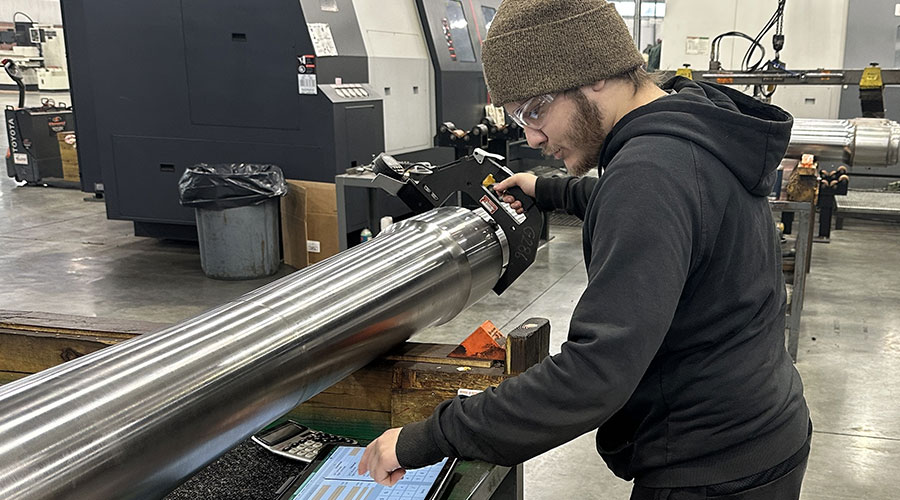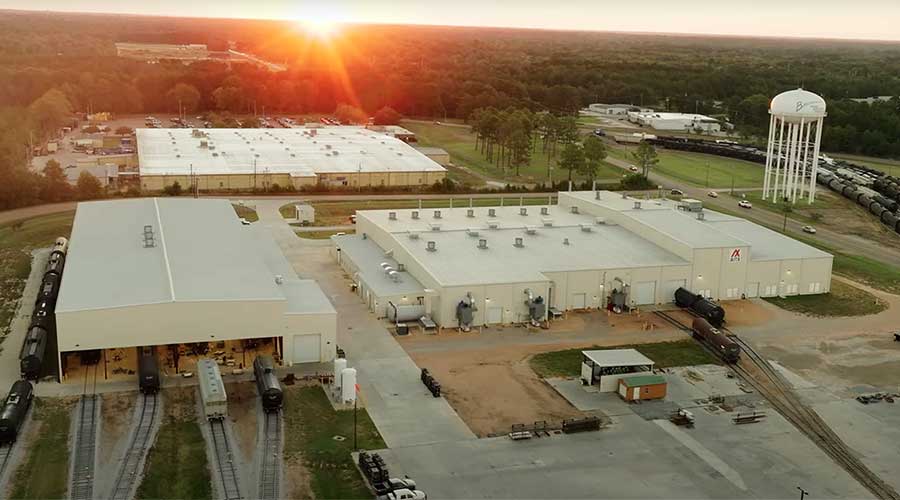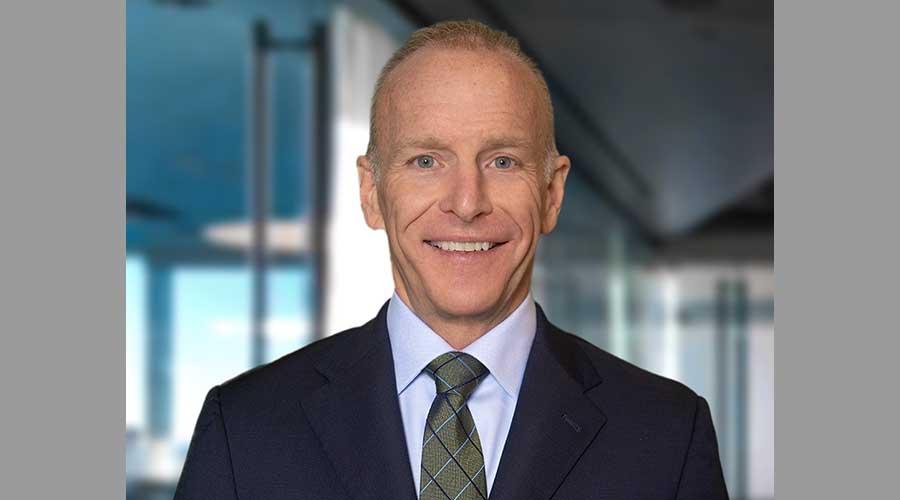Stay updated on news, articles and information for the rail industry
September 2011
Rail News: Short Lines & Regionals
Railroad mechanical department execs sharpen their multi-tasking skills
by Angela Cotey, Associate Editor
A friend recently asked John Kesich if he likes what he does for a living. MTA Metro-North Railroad's chief mechanical officer replied: "It's the best job I've ever had."
Kesich must thrive in a fast-paced environment that calls for master multi-taskers to focus on the forest and the trees. Metro-North's mechanical department is taking delivery of a new fleet of electric multiple units (EMUs); implementing a new asset management program; breaking in a new, state-of-the-art maintenance shop; and stepping up safety efforts to reduce employee injuries.
The railroad needs to carry out those initiatives while also dealing with a few additional challenges. A slow-to-grow economy that's taking a toll on Metro-North's budget, requiring the agency to do more with less. A federally mandated positive train control (PTC) requirement that will impact nearly every piece of Metro-North's rolling stock. A bevy of upcoming employee retirements and, at least in the short term, a limited number of qualified new workers.
"It's probably the most exciting time to have this position," says Kesich. "Metro-North ... is at a point of significant transition with rolling stock, infrastructure and the workforce, so my job is to set a new foundation for the next generation."
Other railroad mechanical department managers share Kesich's enthusiasm — and his challenges. During a series of August interviews, mechanical execs from three Class Is, a regional and three transit agencies discussed current and near-term plans to purchase or rehabilitate rail cars and locomotives, employ new strategies and tweak old ones to ensure rolling stock is operating as efficiently as possible, and implement new technology — all while coping with economic, budgetary, workforce and other issues.
For Metro-North, the efficiency effort starts with replacing a fleet of 40-year-old vehicles. The agency has purchased 380 M-8 electric cars from Kawasaki Rail Car Inc. to operate on the New Haven Line. Metro-North is working with Connecticut officials to order another 25 vehicles, bringing the total contract to 405 cars.
The first 380 vehicles Metro-North ordered are married pairs, meaning every two cars can operate as one train, with each EMU featuring its own operating cab and propulsion system. The final 25 cars will be single vehicles that can operate only when coupled with a car from the married pairs.
"By having these single cars, we've minimized the initial capital expenditure to buy the cars and minimized the lifecycle maintenance because they don't have cabs, signal systems, toilets or propulsion systems," says Kesich.
The Utah Transit Authority (UTA) is in the midst of a big rolling stock acquisition, as well. The agency is taking delivery of 77 S70 light-rail vehicles from Siemens that will operate on several new light-rail lines the agency is building.
Coal Cars A Hot Commodity
Freight railroads are purchasing new rolling stock, too. CSX Transportation plans to add 250 locomotives to its fleet this year through a combination of purchases, leases and rebuilds, Vice President-Mechanical Gary Bethel said in an email. And in addition to 3,000 coal cars that entered service earlier this year, the Class I plans to purchase or lease 3,800 rail cars, mainly to support growing coal business.
Kansas City Southern is purchasing 30 locomotives this year, and "will monitor growth to determine if more are needed next year," said spokesperson Doniele Carlson in an email, adding that the Class I also is working on a 100-car lease and looking into repowering more of its older four-axle locomotives.
Earlier this year, Norfolk Southern Railway purchased 1,500 coal cars from FreightCar America Inc. Now, the railroad is in the process of ordering another 1,500 from the car builder, says VP-Mechanical Tim Heilig. As NS refines its capital plan for 2012, there are indications the Class I might purchase more cars in the coming year, Heilig says.
"We're faced with the task of addressing our coal car fleet over the next eight years or so," he says. "With respect to our locomotive fleet and car fleet, we are positioning ourselves to handle the level of business that is being forecast in the coming years."
NS has an aggressive capital rebuild program, too.
"We look for ways to take a locomotive which had otherwise ... met its life requirement and we breathe some new life into it and essentially create an asset that will last another 15 or 20 years," says Heilig.
For example, the Class I is putting a new control system and engine in switch engines purchased in the 1960s. The railroad also is upgrading an old SD60 six-axle locomotive with patent-pending technology that will "replicate a lot of things that a new locomotive has," says Heilig.
"If you can rebuild a locomotive that in many ways is competitive with a new locomotive for half the price, that's just good business," he says. "This has been going on for awhile, but probably not to the extent of what we're doing right now."
Fleet make-up isn't the only thing that factors into the efficiency equation. How that fleet is maintained is equally important.
"By making sure our locomotive and car fleets perform at an optimal level, our customers benefit, and that drives a return to our investors," says Heilig.
At CSXT, mechanical department managers place particular emphasis on inspection and repair quality.
"We want to prevent equipment failures by making sure we perform the highest quality repair or maintenance while that equipment is shopped," Bethel wrote in an email. "We have metrics to monitor how well we are doing in that regard, and to help us continually improve."
Many transit agencies also have preventative maintenance programs, including Dallas Area Rapid Transit (DART); workers inspect light-rail vehicles every 10,000 miles and complete a trending analysis to determine if they are making repairs or replacing components at the optimum time.
"You're always trying to balance vehicle and service reliability with cost, so you have to look at those failures that occur prematurely, those that occur in service and those you anticipated," says Assistant VP of Fleet Services Joe Coker.
For Metro-North, budget cuts during the past several years have required all agency departments to "basically do things smarter than we've been doing in the past," says Kesich.
"It requires the workforce and the organization to now use a higher level of business skills in their day-to-day operations," he adds.
Department managers used to require Metro-North employees to work overtime if they needed to finish repairing locomotives. Today, managers have to determine if the risk of running out of available locomotives outweighs the cost of paying employees overtime.
"We have to make conscious decisions on where we apply our resources and when to minimize costs," says Kesich.
To that end, Metro-North's parent organization — the Metropolitan Transportation Authority — is working to implement "PAS-55," an integrated lifecycle asset management standard developed in 2008 by the British Standards Institution, across all of its agencies and departments. For the Metro-North mechanical team, the PAS-55 standard would be used to ensure rolling stock is maintained as cost-efficiently as possible.
For example, managers would identify the elements of each locomotive that are essential to the unit's operation, such as the propulsion and braking systems. Those components would need to be maintained at the highest level to ensure service reliability. However, the agency would hold off on repairing other "bells and whistles" that don't contribute directly to the locomotive's ability to operate, says Kesich.
"Instead of maintaining all the systems on a locomotive at the same expense and level of effort, you identify the mission-critical systems and identify the mission-critical reliability items within those systems, and you gear your resources to maintain those," he says.
Ranking Priorities
Transit agencies and freight railroads might be pinching pennies wherever possible, but they haven't halted spending. Railroads are investing when and where it makes sense, particularly in technology that can boost efficiency and save money over the long run.
For example, UTA is upgrading its maintenance management and equipment tracking system. The aim: to help shop workers better track work orders, assigned parts, and costs to maintain specific vehicles and parts. The new system also will enable workers to keep better repair records and order parts using wireless devices.
"We could have the parts department pulling parts off shelves before the maintenance department even gets to the parts room," says Jason Carpenter, UTA's manager of rail vehicle maintenance. "The whole process will save us a lot of time inputting information and retrieving information we want."
CSXT is implementing new asset-management technology, as well. The Class I is transitioning its mechanical data storage from a mainframe system to a web-based one.
"It allows us to better track the quality of repairs and maintenance in the locomotive fleet, and to make more accurate determinations as to the useful life of components," CSXT's Bethel said. "On the rail-car side, we continue to stress inspections and the use of data from a variety of wayside monitoring devices."
During the past few years, Iowa Interstate Railroad Ltd. (IAIS) has installed global positioning systems and health monitoring systems on its locomotives. In 2008, the regional purchased 14 Evolution® Series (ES44AC) locomotives from GE Transportation.
"We're still looking at technology, but we're trying to learn to walk before we run," says IAIS Vice President and Chief Operating Officer Mick Burkart. "We have the new locomotives, which are very advanced, and we're trying to see what we can do with them before we take any other steps."
Shopping Around
Technology and new standards might help mechanical departments keep equipment in tip-top shape, but how do freight railroads and transit agencies maximize worker productivity? For many, it begins with the shops. At IAIS, that means building facilities so workers can get out of the elements.
Later this month, the railroad expects to open a new car shop in Silvis, Ill., that will feature two inside tracks with capacity for six cars, says Burkart. IAIS also has begun preliminary construction on a new locomotive shop in Homestead, Iowa, where workers can maintain the new ES44ACs. The railroad hopes to open that facility in mid-2012.
"We've gotten to the point where we could afford to make these investments in our future," says Burkart.
In fall 2010, Metro-North opened a new Croton-Harmon Shop that replaces the agency's oldest and largest locomotive and coach repair facility, which was built in 1904. Next up: building a new EMU shop.
The new locomotive and coach shops each feature six tracks, and the coach shop can accommodate a complete trainset — with a locomotive and eight coach cars — entirely indoors. The facility also features a storage and retrieval system that delivers parts and track inventory directly to workers.
At NS, mechanical department officials are particularly proud of the Class I's Juniata locomotive shop in Altoona, Pa., the railroad's primary facility for heavy repair work. It's the only locomotive shop in the country that's been used to simultaneously assemble locomotives for NS, GE and Electro-Motive Diesel Inc., says NS' Heilig.
But as mechanical execs work to maximize worker productivity, cut costs and boost rolling stock reliability, they have some factors working against them. Chief among them: a federal mandate that requires railroads to install PTC on the nation's major freight-rail lines, and commuter and intercity passenger-rail routes by 2015's end. The mandate affects all Class Is, and many commuter and regional railroads.
The mechanical departments of those railroads and transit agencies now need to install PTC equipment onboard locomotives — an expensive undertaking, particularly for those with large fleets.
"We have a number of things on the forefront today that suck up capital, like positive train control," says NS' Heilig.
NS has devoted capital dollars and manpower into ensuring the Class I will be able to comply with the federal mandate, and is "probably further along with the development and deployment of the locomotive-based technology that will drive the PTC system," Heilig adds.
Although most freight railroads, commuter agencies and Amtrak need to primarily equip locomotives with PTC systems, Metro-North needs to install the devices on nearly all of its equipment — about 1,000 pieces of rolling stock, says Kesich. That's because the agency operates EMUs, and any of the cars could be on the lead end of a train. It will cost Metro-North about $350 million to retrofit its equipment and install wayside PTC systems, Kesich says.
And workers will be doing it at a time when agency retirements are likely to peak. Metro-North was founded in 1983 and has a 30-year pension system, which means 2013 will be a big year for retirements.
"We're already having a high turnover of the workforce ... and we're bringing in new individuals with different skill sets that we need to train and transfer that experience from the past to the new workforce," says Kesich.
Workforce Woes
The problem isn't unique to Metro-North. Many other freight and passenger railroads are dealing with similar workforce issues. What's more, the pool of potential replacements is limited.
"Blue collar work is no longer valued. As children grow up, the intent is to finish high school, go to college and have a white collar job," says Kesich. "The pool of people that have this base mechanical aptitude has diminished, and it makes it that much more difficult to get qualified people, and then train and develop them."
UTA's mechanical department is facing a similar problem. The agency is hiring new mechanics, particularly on the light-rail side, as UTA continues to expand the system. Although finding qualified workers has been a challenge, agency managers have had some success in hiring workers that have conducted maintenance activities in other industries. They've also recruited some workers from a nearby Air Force base. But training workers with no prior rail experience is a "lengthy process," says UTA's Carpenter.
That's why DART has a four-year, in-house training program for its maintenance employees. Workers have to complete the entire program to progress to the top classification of mechanics. There are 17 different skill classes and each one has their own maintenance training program, says DART's Coker.
"It doesn't matter what level of education or experience someone has, they all start at the entry level," he says.
After putting workers through such an extensive training program, DART managers want to retain those employees. And if they're serious about retention, they'll need to embrace the cultural and generational differences among these new workers.
"What a baby boomer wants and expects is different from Generation X and Y," Coker says.
To gauge those expectations, DART surveys employees, targeting different age groups, genders and ethnicities, to determine what qualities they value in a supervisor.
"We're going to have some significant turnover in the next 10 to 15 years, so that's part of our succession planning process," says Coker.
At CSXT, one quarter of the mechanical workforce has 30 or more years of service. The Class I is preparing for a significant turnover during the next several years.
"We are looking at various ways to pair our experienced workers with those who are just entering the workforce to take advantage of the veterans' knowledge and skills," CSXT's Bethel wrote in an email.
Quality Over Quantity
With current and pending retirements, NS has "no shortage of opportunities" for people in skilled crafts to find jobs, says Heilig. But even with today's high unemployment rate, people aren't lining up for railroad jobs, he adds. And although NS is hiring, it won't sacrifice quality for quantity.
"We want to make sure we hire the right people, so we don't just go to a cattle call to increase the numbers," says Heilig. "We're very particular about who we hire, regardless of the position."
All railroads need to be. Mechanical department workers are charged with ensuring freight and transit fleets are reliable, and department managers expect a lot from their employees. In turn, workers can find job security and satisfaction, says Heilig.
"Lifestyles are a little bit different, but for people that want to work, make a good living and find some security, I can't think of another place in today's world where they would find a better opportunity than within the rail industry," he says.
And specifically in the mechanical department, where efforts to modernize fleets, boost efficiency and implement new technology are creating, as Metro-North's Kesich put it, some pretty exciting times.
Keywords
Browse articles on railroad mechanical mechanical department EMUs locomotive locomotive shop locomotive repair rail car repair railcar repair freightcar repair freight car repair railroad employment railroad hiring railroad workforce railroad fleet rolling stock locomotive technology locomotive healthContact Progressive Railroading editorial staff.


 2025 MOW Spending Report: Passenger-rail programs
2025 MOW Spending Report: Passenger-rail programs
 Gardner steps down as Amtrak CEO
Gardner steps down as Amtrak CEO
 Guest comment: Oliver Wyman’s David Hunt
Guest comment: Oliver Wyman’s David Hunt
 Women of Influence in Rail eBook
Women of Influence in Rail eBook
 railPrime
railPrime







